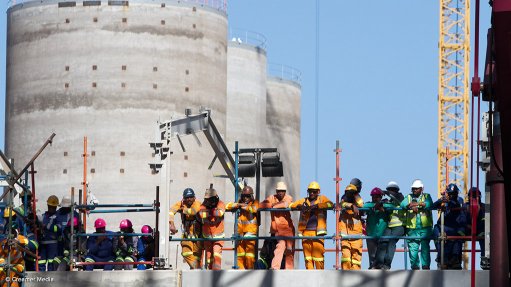
Photo by: Duane Daws
Confidence in the building sector, as measured by the First National Bank (FNB) and Bureau for Economic Research building confidence index, ticked up four index points to 45 in the third quarter, with improvements in residential building activity supporting the rest of the building sector.
FNB noted that the rise in confidence during the quarter was broad based with all but one of the subsectors surveyed having registered higher confidence.
“Although the index remains below the key 50-index point mark, it does suggest that conditions in the building sector improved in the quarter,” FNB property economist John Loos commented.
However, Master Builders South Africa (MBSA) executive director Tumi Dlamini said that, while the organisation welcomed the findings of the index, the company was still extremely concerned about the “pedestrian rate of building activities throughout the country”, particularly in the nonresidential sector, and its effects on job creation.
“MBSA notes with concern that the confidence index remains well below the 50-index point mark – a key target that to us will signify potentially sustainable positive outlook,” she added.
The bank pointed out that the confidence of main contractors increased by eight points to 53, its highest level since the first quarter of 2008, on the back of a sharp rise in residential building activity.
“This is encouraging, as the residential building sector has been under significant pressure since the end of the housing boom in the mid-2000s,” Loos noted.
However, building activity in the nonresidential market remained largely unchanged during the quarter.
Further, FNB also noted that the outlook for coming quarters was optimistic.
“There are indications that demand for building work, especially residential building, should remain well supported,” Loos said.
He added that the rise in residential contractor activity had also resulted in improvements along the remainder of the building value chain.
A sharp rebound in sales saw the confidence of building material retailers rise 18 points to an almost six-year high of 74 index points.
Similarly, an increase in production and domestic sales lifted the confidence of manufacturers of building material by four points, while subcontractor confidence also increased by four points.
“[Subcontracting] is a lagging sector and it is not surprising that the rise in nonresidential building activity registered a few quarters ago is now starting to filter through to nonresidential subcontractors.
“Furthermore, we are likely to see the residential subcontractor market improve in subsequent quarters based on the third-quarter survey results,” Loos said.
Meanwhile, the building pipeline continued to produce mixed results with the confidence of architects edging marginally higher, while the confidence of quantity surveyors declined by eight points to 37 index points, despite a rise in activity.
Dlamini added that, given the current trading conditions in the building industry, MBSA hoped that the slight upsurge in confidence in the FNB/BER index would not merely be a temporary reprieve but that the industry would now continue to see further growth going into 2015.